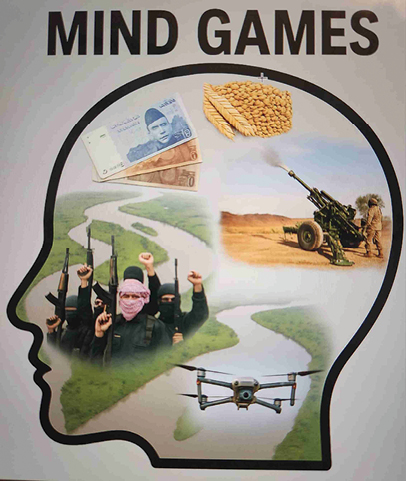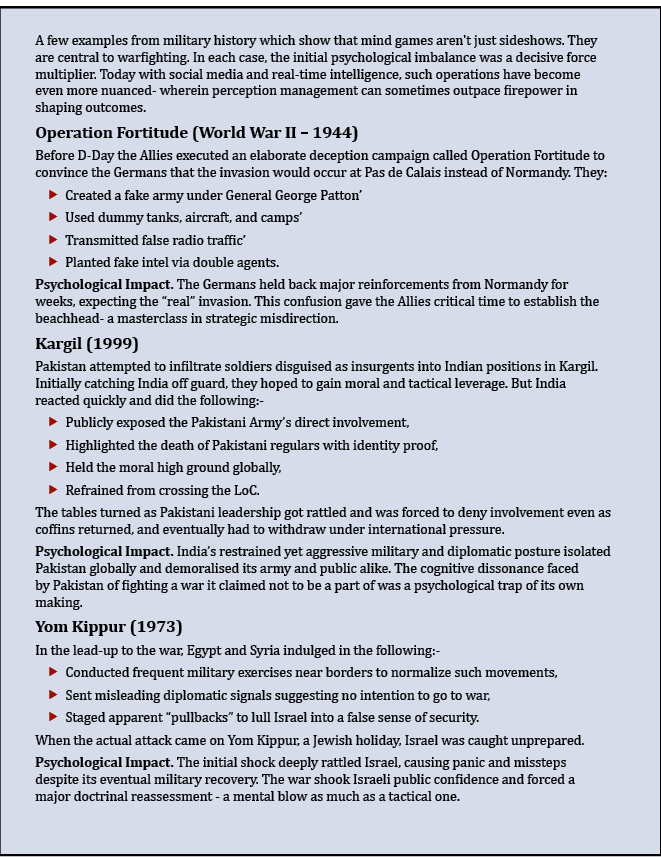
Articles
Mind Space :The New Strategic Battle Space
Sub Title : In the era of Narrative wars, MindSpace is emerging as yet another battle domain
Issues Details : Vol 19 Issue 2 May – Jun 2025
Author : Ashwani Sharma, Editor-in-Chief
Page No. : 60
Category : Military Technology
: June 3, 2025

Mind games may not win wars on their own, but they can shape the battlefield even before the first shot is fired. In the current Indo-Pak imbroglio, that battlefield is tilted in India’s favour. It also makes a good case study to understand this new battlespace.
Here are some statements emerging from Pakistan:
In a recent interview, Pakistan’s Defence Minister Khawaja Asif acknowledged Pakistan’s historical involvement in supporting terrorism, stating that Pakistan had engaged in terrorist activities under the direction of the U.S., Britain, and the West for three decades.
Pakistani Railways Minister Hanif Abbasi escalated tensions by threatening a full-scale nuclear war against India, and warned of launching nuclear warheads named Ghori and Ghaznavi.
“Either water will flow in this Indus, or their blood will” stated former Pakistani Foreign Minister Bilawal Bhutto Zardari, in response to India’s suspension of the Indus Water Treaty, This remark was widely criticised.
In the modern age, wars are no longer fought only with guns and missiles. The most effective battles are now fought in the ‘Mindspace’ – through messaging, perception, and psychological pressure. A smart adversary doesn’t always need to strike physically. Sometimes, creating fear, confusion, or the sense of an impending strike is enough to force the other side into disarray.
We are seeing this unfold in real-time in the aftermath of the Pahalgam terror attack, where Pakistani-backed terrorists targeted innocent Indian tourists. India’s response has been sharp, but also calculated, sending strong signals, holding high-level security meetings, making public declarations; all while keeping Pakistan guessing. These are mind games at their finest, and Pakistan’s confused reactions are proof that they’re working.
Strategic Ambiguity with Maximum Impact. Following the Pahalgam massacre, Prime Minister Narendra Modi made a strong statement – the Armed Forces have complete freedom to respond in the manner they see fit. While no specific action was detailed, this one line has had a huge psychological impact.
Pakistan’s leadership, both civilian and military went into a huddle. The confusion was evident as conflicting statements came from different quarters. While the Pakistani foreign office spoke of peace, their defence analysts appeared on TV debates talking about “red lines” and escalation. The absence of clarity on India’s exact response is precisely the pressure point, forcing Pakistan to second-guess every move.
Indus Treaty Under Pressure (The water card). India’s announcement to place the Indus Waters Treaty in abeyance added another layer of psychological warfare. Though the process to alter water flows from western rivers is complex and time consuming, the message sent to Pakistan was loud and clear – ‘nothing is off the table’. This created panic in Islamabad. Pakistani media ran fear-mongering headlines about droughts and crop failures. Experts were hurriedly called to TV studios to explain the implications. While no dam has yet been built or water blocked, the very thought of India turning off the tap sent shockwaves through Pakistan’s strategic community.
That’s the power of psychological signalling.
Creating Perception of Imminent Action. The series of meetings chaired by the Indian PM, from the Cabinet Committee on Security (CCS) to the CEC and CPC, were widely covered by Indian media. Each meeting fuelled speculation – Is a strike being planned? Are surgical teams on standby? (it’s a different matter that one of them turned out to be a domestic political surgical strike!)
This constant churn in the information space has served one clear purpose, that of keeping Pakistan in a state of alert and uncertainty. The Pakistani military is reportedly placed on high alert along the LoC, air bases have been put on standby, and diplomatic channels were activated quietly behind the scenes.
And yet, no actual strike has happened, at least not immediately. The psychological burden of preparing for the unknown has its own costs. Keeping forces deployed, fuelled, and tense drains resources and weakens morale over time.he Media and Social Media Battlefield. Indian media has played an important role in reinforcing the narrative that India will respond decisively but unpredictably. Meanwhile, in Pakistan, news channels scrambled to decode India’s strategy, often making wild guesses. This added to the chaos within their domestic information ecosystem.
Social media in India was flooded with satirical videos, emotional tributes to the victims, and strategic leaks. Every viral tweet or WhatsApp forward about Indian readiness or drone deployment became a small but effective tool of pressure.
Even speculative visuals like Indian special forces near the border, or aircraft movements in Punjab created a sense of dread in Pakistani circles. Information warfare and perception control are now as important as physical troop movements.
Pakistan’s Jittery Response. Pakistan’s response has shown signs of stress. On one hand, they deny involvement in the Pahalgam attack. On the other hand, they’ve moved terror training camps deeper into PoK, fearing another Balakot-style strike. Reports suggest that Pakistan’s National Security Council held emergency meetings to assess India’s possible actions once again, without clarity.
In conclusion, it is about shaping the Battlefield Before the Battle. India has smartly leveraged psychological tools in the current Indo-Pak scenario from diplomatic signals and media narratives to high-profile meetings and ambiguous military posturing. All of this has kept Pakistan off balance, nervous, and on the defensive.
This approach allows India to exert pressure without entering into full-blown conflict. And in the age of social media and 24×7 news, this kind of non-kinetic warfare may be more effective in many cases than actual bombs.



